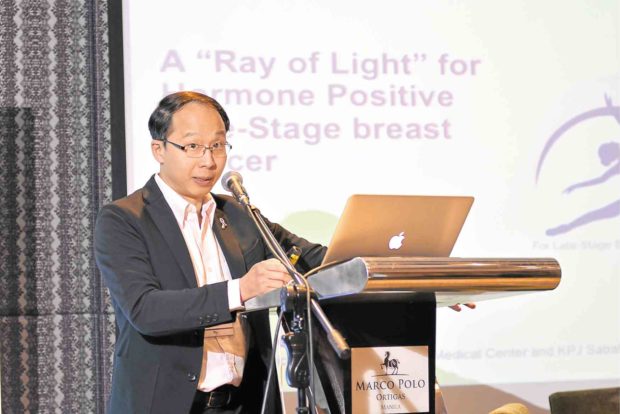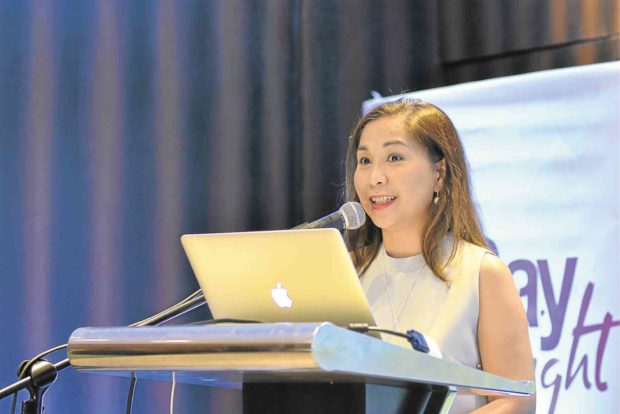
Breast cancer remains the most common and leading cause of death among women in the Philippines, accounting for nearly 27.7 percent of deaths in 2014 alone. That same year, more than 18,000 women were also diagnosed with breast cancer.
According to the Philippine Council for Health Research and Development, one out of 13 Filipino women is expected to develop breast cancer in her lifetime.
“The greatest risk of getting breast cancer is simply by being a female,” said Dr. Maria Luisa Abesamis Tiambeng, consultant for medical oncology at Cardinal Santos Medical Center.
While some patients notice some breast pain, breast cancer is usually a painless lump. Symptoms may include a change in breast size; dimpling (when the breast is not completely round but pulls in at some point); flaking or thickening of the breast skin; a newly inverted nipple; rash or discharge; swelling of the upper arm or armpit where lymph nodes are; and redness or pitting of the skin over the breast, like that of an orange peel.
The best chance for surviving breast cancer is early detection, but unfortunately in the Philippines, many are diagnosed at Stage 3 or 4 because the country, Tiambeng said, doesn’t have a national screening program. Screening is not subsidized, and awareness is not very widespread. Only 55 percent survive Stage 3 breast cancer for more than five years and only 15 percent survive Stage 4.
Not curable
Breast cancer stage depends on tumor size, the number of lymph nodes involved, and distant metastasis. Stage 0 has no palpable lump and has zero chance of spreading to other organs; Stage 1 involves a mass less than 2 cm, and cancer that hasn’t spread to the axilla or lymph nodes; Stage 2 is more than 2 cm in size and can sometimes involve the lymph nodes; Stage 3 is more than 5 cm, with lymph node involvement; and Stage 4 means cancer has spread from the breast to other organs like the lungs, brain and bones.
Stage 4 is not curable, but there is a treatment, Tiambeng said.
“The goal of treatment is to optimize the patient’s life and quality of life. Stage 4 is no longer solely dependent on chemotherapy. There are now other options, depending on the tumor class of the breast cancer,” she said.
Tumor class is not dependent on stage, type of tumor or the number of lymph nodes involved, but rather on the biology of the disease, such as the characteristics of the tumor.
About 75 percent of all breast tumors are hormone-receptor positive and require hormonal therapy; 20 percent are HER2 positive, a very aggressive class of tumor that needs targeted therapy or smart drugs; about 10-20 percent are triple negative breast cancer (TNBC), where chemotherapy is the only approved drug choice; and some have inherited mutations like BRCA1 or BRCA2.
“In advanced breast cancer, because you’re not aiming to cure them, you ask them what they want in life. Many are mothers who just want to see their children graduate from school, or attend their children’s wedding with their hair still intact,” said Dr. Daren Teoh, a clinical oncologist at Rafflesia Medical Center and KPJ Sabah Specialist Hospital in Malaysia.
Teoh was in the country to discuss treatment options for advanced breast cancer patients.
For those with hormone-receptor positive cancer, he said, hormone (endocrine) therapy, or tamoxifen and aromatase inhibitors (for postmenopausal women), are commonly used endocrine therapies. More recently, endocrine therapies have been combined with other agents such as palbociclib.
Like chewing gum
“Tamoxifen was developed in the ’80s. It’s like a chewing gum—it blocks cancer cells so they can no longer feed, and they go into hibernation or die,” Teoh said.
The HER2 targeted therapy uses trastuzumab or aromatase inhibitor that is given together with chemotherapy; TNBC requires chemotherapy, or a combination of targeted therapy, usually with single agents, and inherited mutation treatment needs PARP inhibition, a class of systemic agents that works by preventing the BRCA mutated cancer cell from repairing DNA damage.
“A new treatment for the common hormone-receptor positive cancer is fulvestrant for postmenopausal women. Fulvestrant blocks the cancer cells and destroys it, so it can’t continue eating, targeting the estrogen receptor that inhibits tumor cell growth,” he said.

To date, it is the only hormone therapy for advanced breast cancer that “slows tumor growth by binding to and degrading the estrogen receptor, a key driver of breast cancer progression.” Meaning, it can show activity against tumors that have become resistant to tamoxifen.
Tiambeng recommends women start mammography between 40 and 44 years old, and an annual mammography at 45-54. If results have been normal for the last 10 years, 55 and older can have a mammography every other year or may continue yearly screening if the woman is healthy and expected to live 10 years longer.
Patients can reach out to the Philippine Charity Sweepstake Office (PCSO) for financial aid. Hospitals now have a dedicated PCSO desk, so there’s less lining up at its headquarters in Quezon City. They may also seek assistance via the Breast Cancer Medicines Access Program (BCMAP) of the Department of Health. PhilHealth subsidizes chemotherapy up to P7,000 per cycle.














































